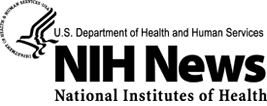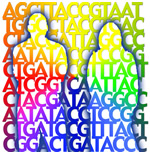Last updated: December 13, 2011
International genome consortium discovers new genes that control blood pressure

National Heart Lung and Blood Institute
www.nhlbi.nih.gov
National Human Genome Research Institute
www.genome.gov
International genome consortium discovers new genes that control blood pressure
NIH institutes participate in global study that finds new genetic risk factors for cardiovascular disease

"It is fitting that a global research group came together to provide new insight into a condition that affects over 1 billion people worldwide," said Susan B. Shurin, M.D., acting director of the NIH's National, Heart, Lung, and Blood Institute (NHLBI), which was part of the international consortium behind the study. "This is one of the most important studies of the genetics of blood pressure to date and a significant step toward finding better therapies for it."
Sixteen of the 29 variations identified in the study were previously unrecognized. Six of the new variations were found in genes already suspected of regulating blood pressure; the other 10, which were found in unexpected locations, provide new clues into how blood pressure is regulated.
Individually, the genetic variations increased the risk of hypertension (high blood pressure) by only a tiny amount. For people with multiple variants, however, the effects were more significant.
The research team developed a blood pressure genetic risk score by combining variant combinations (with someone having many variants toward the top, and someone with very few at the bottom). They found that people in the top 10 percent of the genetic risk score had blood pressure readings that were 5.8 mm/Hg and 3.7 mm/Hg higher for the systolic and diastolic values, respectively, than the lowest 10 percent risk score group. Systolic refers to blood pressure as the heart is pumping blood, while diastolic refers to blood pressure between heartbeats.
In line with the increased values, hypertension also increased with risk score; 29 percent of people in the highest risk group had hypertension, compared to 16 percent in the lowest risk group. The risk score was also a good indicator of hypertension complications such as increased thickness of heart chambers, heart failure, stroke, and coronary artery disease. The risk score, however, was not a good indicator of the risk of kidney disease, another common hypertension-related problem.
The primary group of 200,000 participants was of European background and included subjects selected from several NHLBI study populations including the Framingham Heart Study (FHS). The research consortium then followed up its analysis on 70,000 people of East Asian, South Asian, and African ancestry. The researchers found that the genetic risk score and several of the individual variants were associated with increased blood pressure in these ethnic groups as well.
"This study demonstrates the continuing value of large cohorts like Framingham, which started in 1948 and is still helping scientists uncover the genetics and biology of diseases today," said Daniel Levy, M.D., one of the co-leaders of this project and director of the FHS.
In addition to the NHLBI, the NIH's National Institute on Aging and the National Human Genome Research Institute also participated in and supported the study.
To schedule an interview with an NHLBI spokesperson, contact the NHLBI Office of Communications at 301-496-4236 or NHLBI_news@nhlbi.nih.gov.
To schedule an interview with NHGRI, contact Ray McDougall at 301-402-0911 or macdougallr@mail.nih.gov
Resources:
The National Heart, Lung, and Blood Institute (NHLBI) is a component of the National Institutes of Health. NHLBI plans, conducts, and supports research related to the causes, prevention, diagnosis, and treatment of heart, blood vessel, lung, and blood diseases; and sleep disorders. The Institute also administers national health education campaigns on women and heart disease, healthy weight for children, and other topics. NHLBI press releases and other materials are available online at: www.nhlbi.nih.gov.
The National Institute on Aging (NIA) leads the federal government effort conducting and supporting research on aging and the health and well-being of older people. For more information on research, aging, and health, go to www.nia.nih.gov.
NHGRI is one of the 27 institutes and centers at the NIH, an agency of the Department of Health and Human Services. The NHGRI Division of Intramural Research develops and implements technology to understand, diagnose and treat genomic and genetic diseases. Additional information about NHGRI can be found at its website, www.genome.gov.
About the National Institutes of Health (NIH): NIH, the nation's medical research agency, includes 27 Institutes and Centers and is a component of the U.S. Department of Health and Human Services. NIH is the primary federal agency conducting and supporting basic, clinical, and translational medical research, and is investigating the causes, treatments, and cures for both common and rare diseases. For more information about NIH and its programs, visit www.nih.gov.
Contact:
NHLBI Communications
301-496-4236
NHLBI_news@nhlbi.nih.gov